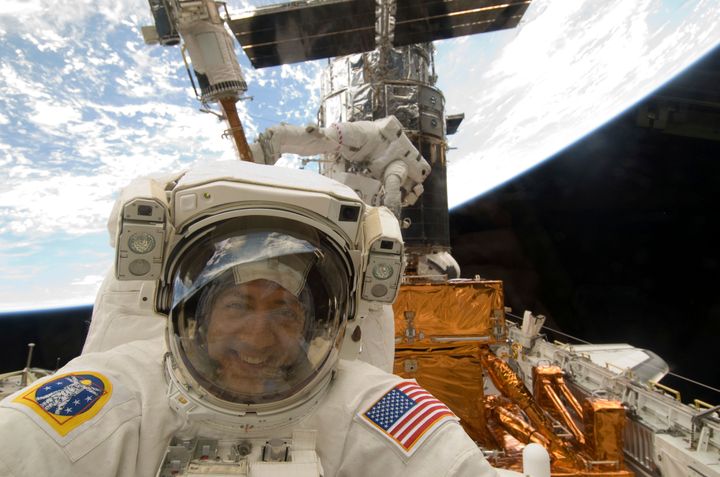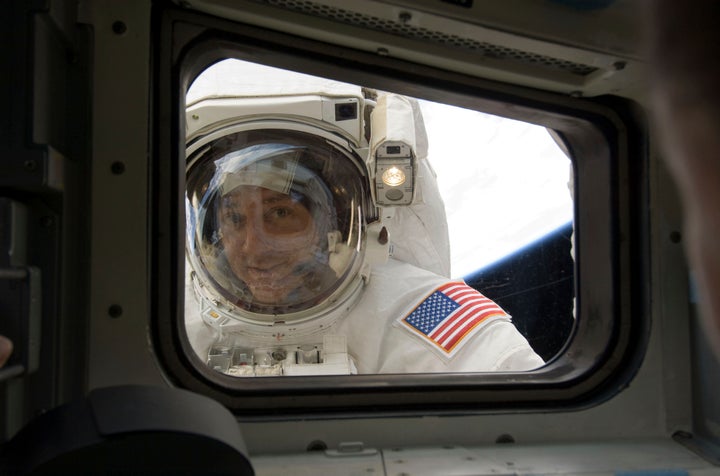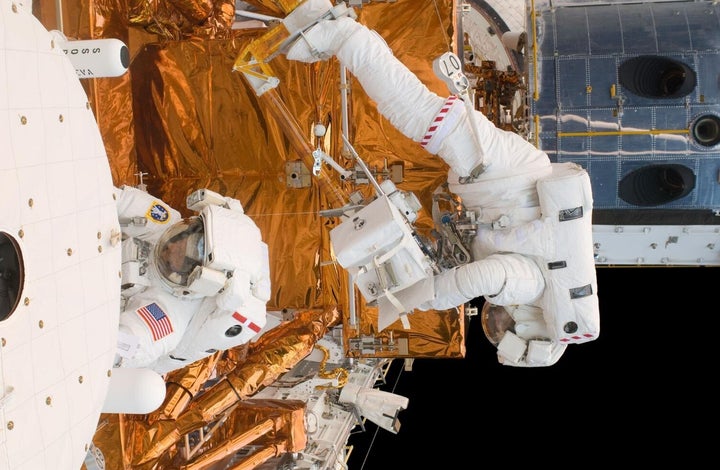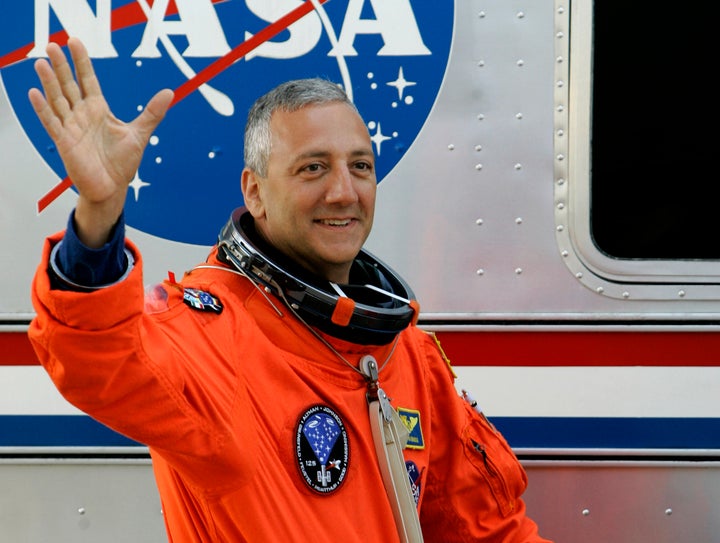

In 1984 I was a senior in college, and I went to see the movie The Right Stuff. And a couple of things really struck me in that movie. The first was the view out the window of John Glenn’s spaceship – the view of the Earth, how beautiful it was on the big screen. I wanted to see that view. And secondly, the camaraderie between the original seven astronauts depicted in that movie – how they were good friends, how they stuck up for each other, how they would never let each other down. I wanted to be part of an organisation like that.
And it rekindled a boyhood dream that had gone dormant over the years. That dream was to grow up to be an astronaut. And I just could not ignore this dream. I had to pursue it. So I decided I wanted to go to graduate school, and I was lucky enough to get accepted to MIT.
While I was at MIT, I started applying to NASA to become an astronaut. I filled out my application, and I received a letter that said they weren’t quite interested. So I waited a couple years, and I sent in another application. They sent me back pretty much the same letter. So I applied a third time, and this time I got an interview, so they got to know who I was. And then they told me no.
So I applied a fourth time. And on April 22, 1996, I knew the call was coming, good or bad. I picked up the phone, and it was Dave Leestma, the head of flight crew operations at the Johnson Space Center in Houston.
He said, “Hey, Mike. This is Dave Leestma. How you doing this morning?”
And I said, “I really don’t know, Dave. You’re gonna have to tell me.”
And he said, “Well, I think you’re gonna be pretty good after this phone call, ’cause we wanna make you an astronaut.”
Thirteen years after that, it’s May 17, 2009, and I’m on space shuttle Atlantis, about to go out and do a spacewalk on the Hubble Space Telescope. And our task that day was to repair an instrument that had failed. This instrument was used by scientists to detect the atmospheres of far-off planets. Planets in other solar systems could be analysed using this spectrograph to see if we might find a planet that was Earth-like, or a planet that could support life. And just when they got good at doing this, the power supply on this instrument failed. It blew. So the instrument could no longer be used.
“If you look over the edge of the shuttle, it’s like looking over a cliff, with 350 miles to go down to the planet.”
And there was no way really to replace this unit or to repair the instrument, because when they launched this thing, and they got it ready for space flight, they really buttoned it up. They didn’t want anybody to screw with this thing. It was buttoned up with an access panel that blocked the power supply that had failed. This access panel had 117 small screws with washers, and just to play it safe, they put glue on the screw threads so they would never come apart. You know, it could withstand a space launch, and there was no way we could get in to fix this thing.
But we really wanted the Hubble’s capability back, so we started working. And for five years, we designed a spacewalk. We designed over one hundred new space tools to be used—at great taxpayers’ expense, millions of dollars, thousands of people worked on this. And my buddy Mike Good (who we call Bueno)—he and I were gonna go out to do this spacewalk. I was gonna be the guy actually doing the repair.
And inside was Drew Feustel, one of my best friends. He was gonna read me the checklist. And we had practiced for years and years for this. They built us our own practice instrument and gave us our own set of tools so we could practice in our office, in our free time, during lunch, after work, on the week- ends. We became like one mind. He would say it, I would do it. We had our own language. And now was the day to go out and do this task.
The thing I was most worried about when leaving the airlock that day was my path to get to the telescope, because it was along the side of the space shuttle. And if you look over the edge of the shuttle, it’s like looking over a cliff, with 350 miles to go down to the planet. And there are no good handrails.
When we’re spacewalking, we like to grab on to things with our space gloves and be nice and steady. But I got to this one area along the side of the shuttle, and there was nothing good to grab. I had to grab a wire or a hose or a knob or a screw. And I’m kind of a big goon. And when there’s no gravity, you can get a lot of momentum built up, and I could go spinning off into space. I knew I had a safety tether that would probably hold, but I also had a heart that I wasn’t so sure about. I knew they would get me back, I just wasn’t sure what they would get back on the end of the tether when they reeled me in. So I was really concerned about this. I took my time, and I got through the treacherous path and out to the telescope.
The first thing I had to do was to remove a handrail from the telescope that was blocking the access panel. There were two screws on the top, and they came off easily. And there was one screw on the bottom right and that came out easily. The fourth screw is not moving. My tool is moving, but the screw is not. I look close and it’s stripped. And I realise that that hand- rail’s not coming off, which means I can’t get to the access panel with these 117 screws that I’ve been worrying about for five years, which means I can’t get to the power supply that failed, which means we’re not gonna be able to fix this instrument today, which means all these smart scientists can’t find life on other planets.
And I’m to blame for this.

And I could see what they would be saying in the science books of the future. This was gonna be my legacy. My children and my grandchildren would read in their classrooms:
We would know if there was life on other planets... but Gabby and Daniel’s dad... My children would suffer from this.
Gabby and Daniel’s dad broke the Hubble Space Telescope, and we’ll never know.
And through this nightmare that had just begun, I looked at my buddy Bueno, next to me in his space suit, and he was there to assist in the repair but could not take over my role. He had his own responsibilities, and I was the one trained to do the now broken part of the repair. It was my job to fix this thing. I turned and looked into the cabin where my five crewmates were, and I realised nobody in there had a space suit on. They couldn’t come out here and help me. And then I actually looked at the Earth; I looked at our planet, and I thought, There are billions of people down there, but there’s no way I’m gonna get a house call on this one. No one can help me.
I felt this deep loneliness. And it wasn’t just a ‘Saturday afternoon with a book’ alone. I felt... detached from the Earth. I felt that I was by myself, and everything that I knew and loved and that made me feel comfortable was far away. And then it started getting dark and cold.
Because we travel 17,500 miles an hour, ninety minutes is one lap around the Earth. So it’s 45 minutes of sunlight and 45 minutes of darkness. And when you enter the darkness, it is not just darkness. It’s the darkest black I have ever experienced. It’s the complete absence of light. It gets cold, and I could feel that coldness, and I could sense the darkness coming. And it just added to my loneliness.
For the next hour or so, we tried all kinds of things. I was going up and down the space shuttle, trying to figure out where I needed to go to get the next tool to try to fix this problem, and nothing was working. And then they called up, after about an hour and fifteen minutes of this, and said they wanted me to go to the front of the shuttle to a toolbox and get vice grips and tape. I thought to myself, We are running out of ideas. I didn’t even know we had tape on board. I’m gonna be the first astronaut to use tape in space during a spacewalk.
“When you enter the darkness, it is not just darkness. It’s the darkest black I have ever experienced. It’s the complete absence of light.”
But I followed directions. I got to the front of the space shuttle, and I opened up the toolbox and there was the tape. At that point I was very close to the front of the orbiter, right by the cabin window, and I knew that my best pal was in there, trying to help me out. And I could not even stand to think of looking at him, because I felt so bad about the way this day was going, with all the work he and I had put in.
But through the corner of my eye, through my helmet, you know, just the side there, I can kinda see that he’s trying to get my attention. And I look up at him, and he’s just cracking up, smiling and giving me the okay sign. And I’m like, Is there another spacewalk going on out here? I really can’t talk to him, be- cause if I say anything, the ground will hear. You know, Houston. The control centre. So I’m kinda like playing charades with him. I’m like, What are you, nuts? And I didn’t wanna look before, because I thought he was gonna give me the finger be- cause he’s gonna go down in the history books with me. But he’s saying, No, we’re okay. You just hang in there a little bit longer. We’re gonna make it through this. We’re in this together. You’re doing great. Just hang in there.
And if there was ever a time in my life that I needed a friend, it was at that moment. And there was my buddy, just like I saw in that movie, the camaraderie of those guys sticking together. I didn’t believe him at all. I figured that we were outta luck. But I thought, At least if I’m going down, I’m going down with my best pal.
And as I turned to make my way back over the treacherous path one more time, Houston called up and told us what they had in mind. They wanted me to use that tape to tape the bottom of the handrail and then see if I could yank it off the telescope. They said it was gonna take about sixty pounds of force for me to do that.
And Drew answers the call, and he goes, “Sixty pounds of force?”
He goes, “Mass, I think you got that in you. What do you think?”
And I’m like, “You bet, Drew. Let’s go get this thing.”
I get back to the telescope, and I put my hand on that handrail, and the ground calls again, and they go, “Well, Drew, you know, you guys are okay to do this, but right now we don’t have any downlink from Mike’s helmet camera.” I’ve got these cameras mounted on my helmet, so they can see everything I’m doing. It’s kinda like your mom looking over your shoulder when you’re doing your homework, you know?
And they go, “We don’t have any downlink for another three minutes, but we know we’re running late on time here, so if you have to...” And I’m thinking, Let’s do it now while they can’t watch! Because the reason I’m taping this thing is if any debris gets loose, they’re gonna get all worried, and it’s gonna be another hour, and we’ll never fix this thing. We’ve been through enough already.
So I’m like, Let’s do it now, while Mom and Dad aren’t home. Let’s have the party.
So I say, “Drew, I think we should do it now.”

And Drew’s like, “Go!” And bam! That thing comes right off. I pull out my power tool, and now I’ve got that access panel with those 117 little bitty screws with their washers and glue, and I’m ready to get each one of them. And I pull the trigger on my power tool and nothing happens, and I look, and I see that the battery is dead. And I turn my head to look at Bueno, who’s in his space suit, again looking at me like, What else can happen today?
And I said, “Drew, the battery’s dead in this thing. I’m gonna go back to the air lock, and we’re gonna swap out the battery, and I’m gonna recharge my oxygen tank.” Because I was getting low on oxygen; I needed to get a refill.
And he said, “Go.” And I was going back over that shuttle, and I noticed two things. One was that that treacherous path that I was so scaredy-cat-sissy-pants about going over – it wasn’t scary anymore. That in the course of those couple hours of fighting this problem, I had gone up and down that thing about twenty times, and my fear had gone away, because there was no time to be a scaredy-cat, it was time to get the job done. And what we were doing was more important than me being worried, and it was actually kinda fun going across that little jungle gym, back and forth over the shuttle.
The other thing I noticed was that I could feel the warmth of the sun. We were about to come into a day pass. And the light in space, when you’re in the sunlight, is the brightest, whitest, purest light I have ever experienced, and it brings with it warmth. I could feel that coming, and I actually started feeling optimistic.
Sure enough, the rest of the spacewalk went well. We got all those screws out, a new power supply in, buttoned it up. They tried it; turned it on from the ground. The power supply was working. The instrument had come back to life. And at the end of that spacewalk, after about eight hours, I’m inside the air lock getting things ready for Bueno and me to come back in- side, but my commander says, “Hey, Mass, you know, you’ve got about fifteen minutes before Bueno’s gonna be ready to come in. Why don’t you go outside of the air lock and enjoy the view?”
“When you’re in the sunlight, it's the brightest, whitest, purest light I have ever experienced.”
So I go outside, and I take my tether, and I clip it on a handrail, and I let go, and I just look. And the Earth – from our altitude at Hubble, we’re 350 miles up. We can see the curvature. We can see the roundness of our home, our home planet. And it’s the most magnificent thing I’ve ever seen. It’s like looking into heaven. It’s paradise.
And I thought to myself, This is the view that I imagined in that movie theatre all those years ago. And as I looked at the Earth, I also noticed that I could turn my head, and I could see the moon and the stars and the Milky Way galaxy. I could see our universe. And I could turn back, and I could see our beautiful planet.
And that moment changed my relationship with the Earth. Because for me the Earth had always been a kind of a safe haven, you know, where I could go to work or be in my home or take my kids to school. But I realised it really wasn’t that. It really is its own spaceship. And I had always been a space traveler. All of us here today, even tonight, we’re on this spaceship Earth, amongst all the chaos of the universe, whipping around the sun and around the Milky Way galaxy.
A few days later, we get back. Our families come to meet us at the airfield. And I’m driving home to my house with my wife, my kids in the backseat. And she starts telling me about what she was going through that Sunday that I was spacewalking, and how she could tell, listening, watching the NASA television channel, how sad I was. That she detected a sadness in my voice that she had never heard from me before, and it worried her.
I wish I would’ve known that when I was up there, ’cause this loneliness that I felt—really, Carol was thinking about me the whole time. And we turned the corner to come down our block, and I could see my neighbours were outside. They had decorated my house, and there were American flags everywhere. And my neighbour across the street was holding a pepperoni pizza and a six-pack of beer, two things that unfortunately we still cannot get in space.

And I got out of the car, and they were all hugging me. I was still in my blue flight suit, and they were saying how happy they were to have me back and how great everything turned out. I realised my friends, man, they were thinking about me the whole time. They were with me too.
The next day we had our return ceremony; we made speeches. The engineers who had worked all these years with us, our trainers, the people that worked in the control centre, they started telling me how they were running around like crazy while I was up there in my little nightmare, all alone. How they got the solution from the Goddard Space Flight Center in Maryland, and how the team that was working on that Sunday figured out what to do, and they checked it out, and they radioed it up to us.
I realised that at the time when I felt so lonely, when I felt detached from everyone else—literally, like I was away from the planet—that really I never was alone, that my family and my friends and the people I worked with, the people that I loved and the people that cared about me, they were with me every step of the way.
Michael Massimino, Ph.D., is a veteran of two Nasa space flights and has logged a total of 571 hours, 47 minutes in space, and a cumulative total of 30 hours, 4 minutes during four spacewalks. Michael is currently serving as executive director of the Rice Space Institute at Rice University in addition to his responsibilities in the Astronaut Office at Nasa.
You can listen to Michael’s story on The Moth website, and purchase their latest book, Occasional Magic, here.
Have a compelling personal story you want to tell? Find out what we’re looking for here, and pitch us on ukpersonal@huffpost.com